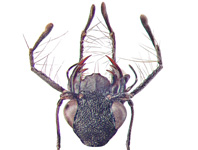Abstract
Hemidactylus Oken, 1817 is one of the most speciose genera of the family Gekkonidae with more than 140 described species (Uetz et al. 2016). While this genus naturally occurs across the tropics and subtropics, a substantial part of its distribution also results from human-mediated dispersal. Carranza & Arnold (2006) retrieved five broad clades in a global phylogeny of Hemidactylus, one of which has species distributed in tropical Asia. Subsequent work by Bauer et al. (2010) and Bansal & Karanth (2010) revealed that the species from tropical Asia fell into two deeply divergent and potentially non-sister sub-clades—one comprising a large radiation confined to peninsular India and Sri Lanka (the Indian radiation, IR), and the other comprising species largely distributed in Southeast (SE) Asia.
References
Bansal, R. & Karanth, K.P. (2010) Molecular phylogeny of Hemidactylus geckos (Squamata: Gekkonidae) of the Indian subcontinent reveals a unique Indian radiation and an Indian origin of Asian house geckos. Molecular Phylogenetics and Evolution, 57, 459–465.
https://doi.org/10.1016/j.ympev.2010.06.008
Bansal, R. & Karanth, K.P. (2013) Phylogenetic analysis and molecular dating suggest that Hemidactylus anamallensis is not a member of the Hemidactylus radiation and has an ancient Late Cretaceous origin. PLoS ONE, 8, e60615.
https://doi.org/10.1371/journal.pone.0060615
Bauer, A.M., Giri, V.B., Greenbaum, E. & Jackman, T.R. (2008) On the systematics of the gekkonid genus Teratolepis Günther, 1869: another one bites the dust. Hamadryad, 33, 13–27.
Bauer, A.M., Jackman, T.R., Greenbaum, E., Giri, V.B. & de Silva, A. (2010a) South Asia supports a major endemic radiation of Hemidactylus geckos. Molecular Phylogenetics and Evolution, 57, 343–352.
https://doi.org/10.1016/j.ympev.2010.06.014
Bauer, A.M., Jackman, T.R., Greenbaum, E., de Silva, A., Giri, V.B. & Das, I. (2010b) Molecular evidence for the taxonomic status of Hemidactylus brookii group taxa (Squamata: Gekkonidae). The Herpetological Journal, 20, 129–138.
Bauer, A.M., Vyas, R., Jackmann, T., Lajmi, A. & Giri, V. (2012) Hemidactylus porbandarensis Sharma, 1981 is a synonym of Hemidactylus robustus Heyden, 1827. Hamadryad, 36, 46–51.
Benson, D.A., Cavanaugh, M., Clark, K., Karsch-Mizrachi, I., Lipman, D.J., Ostell, J. & Sayers, E.W. (2017) GenBank. Nucleic Acids Research, 45, 37–42. [D37–D42]
http://doi.org/10.1093/nar/gkw1070
Carranza, S. & Arnold, E.N. (2006). Systematics, biogeography, and evolution of Hemidactylus geckos (Reptilia: Gekkonidae) elucidated using mitochondrial DNA sequences. Molecular Phylogenetics and Evolution, 38 (2), 531–545.
http://doi.org/10.1016/j.ympev.2005.07.012
Gamble, T., Greenbaum, E., Jackman, T.R., Russell, A.P. & Bauer, A.M. (2012) Repeated origin and loss of adhesive toepads in geckos. PLoS ONE, 7 (6), e39429.
https://doi.org/10.1371/journal.pone.0039429
Gamble, T., Greenbaum, E., Jackman, T.R. & Bauer, A.M. (2015) Into the light: diurnality has evolved multiple times in geckos. Biological Journal of the Linnean Society, 115 (4), 896–910.
https://doi.org/10.1111/bij.12536
Giri, V.B., Bauer, A.M., Vyas, R. & Patil, S. (2009) New species of rock-dwelling Hemidactylus (Squamata: Gekkonidae) from Gujarat, India. Journal of Herpetology, 43 (3), 385–393.
http://doi.org/10.1670/08-137R1.1
Lajmi, A., Giri, V.B. & Karanth, K.P. (2016) Molecular data in conjunction with morphology help resolve the Hemidactylus brookii complex (Squamata: Gekkonidae). Organisms Diversity & Evolution, 16, 659–677.
https://doi.org/10.1007/s13127-016-0271-9
Lanfear, R., Calcott, B., Ho, S.Y.W. & Guindon, S. (2012) Partitionfinder: combined selection of partitioning schemes and substitution models for phylogenetic analyses. Molecular Biology and Evolution, 29 (6), 1695–1701.
http://doi.org/10.1093/molbev/mss020
Murthy, B.H.C.K., Bauer, A.M., Lajmi, A., Agarwal, I. & Giri, V.B. (2014) A new rock dwelling Hemidactylus (Squamata: Gekkonidae) from Chhattisgarh, India. Zootaxa, 4021 (2), 334–350.
https://doi.org/10.11646/zootaxa.4021.2.5Pyron, R., Burbrink, F. T. & Wiens, J. J. (2013) A phylogeny and revised classification of Squamata, including 4161 species of lizards and snakes. BMC Evolutionary Biology, 13 (1), 93.
http://doi.org/10.1186/1471-2148-13-93
Ronquist, F., Teslenko, M., van der Mark, P., Ayres, D. L., Darling, A., Höhna, S., Larget, B., Liu, L., Suchard, M.A. & Huelsenbeck, J.P. (2012) MrBayes 3.2: efficient Bayesian phylogenetic inference and model choice across a large model space. Systematic Biology, 61 (3), 539–542.
http://doi.org/10.1093/sysbio/sys029
Silvestro, D. & Michalak, I. (2012) raxmlGUI: a graphical front-end for RAxML - Springer. Organisms Diversity & Evolution, 12 (4), 335–337.
http://doi.org/10.1007/s13127-011-0056-0
Stamatakis, A. (2014) RAxML version 8: a tool for phylogenetic analysis and post-analysis of large phylogenies. Bioinformatics, 30 (9), 1312–1313.
https://doi.org/10.1093/bioinformatics/btu033
Tamura, K., Peterson, D., Peterson, N., Stecher, G., Nei, M. & Kumar, S. (2011) MEGA5: molecular evolutionary genetics analysis using maximum likelihood, evolutionary distance, and maximum parsimony methods. Molecular Biology and Evolution, 28 (10), 2731–2739.
http://doi.org/10.1093/molbev/msr121
Thompson, J.D., Higgins, D.G. & Gibson, T.J. (1994) CLUSTAL W: improving the sensitivity of progressive multiple sequence alignment through sequence weighting, position-specific gap penalties and weight matrix choice. Nucleic Acids Research, 22 (22), 4673–4680.
https://doi.org/10.1093/nar/22.22.4673
Uetz, P., Freed, P. & Hošek, J. (2016) The Reptile Database. Available from: http://www.reptile-database.org (accessed 18 May 2017)
Wood, P.L., Heinicke, M.P., Jackman, T.R. & Bauer, A.M. (2012) Phylogeny of bent-toed geckos (Cyrtodactylus) reveals a west to east pattern of diversification. Molecular Phylogenetics and Evolution, 65, 992–1003.
https://doi.org/10.1016/j.ympev.2012.08.025

